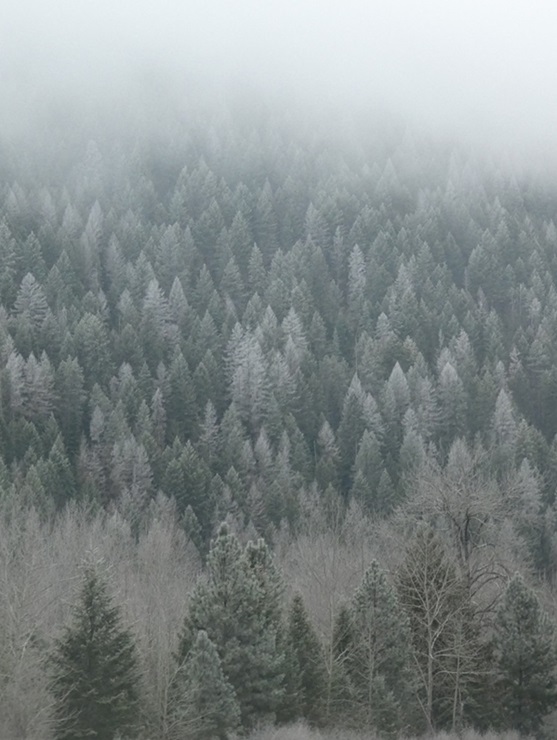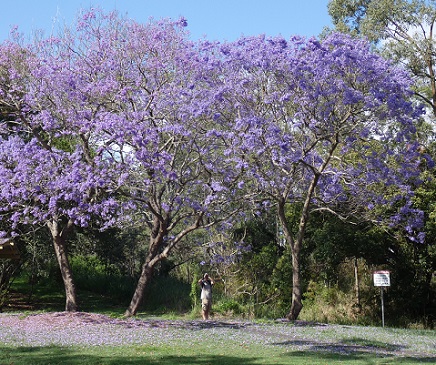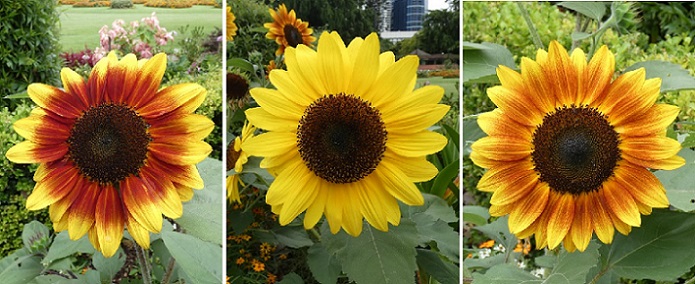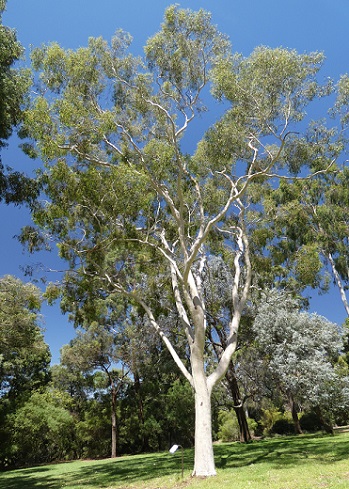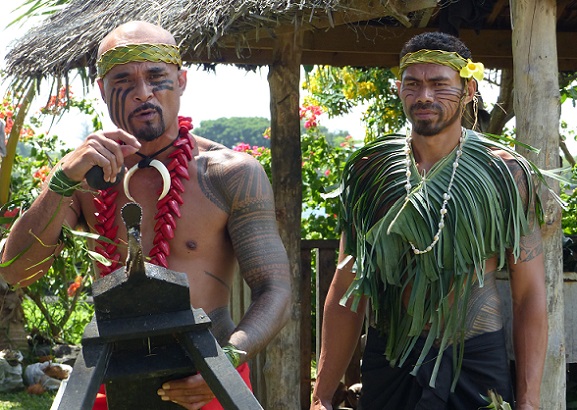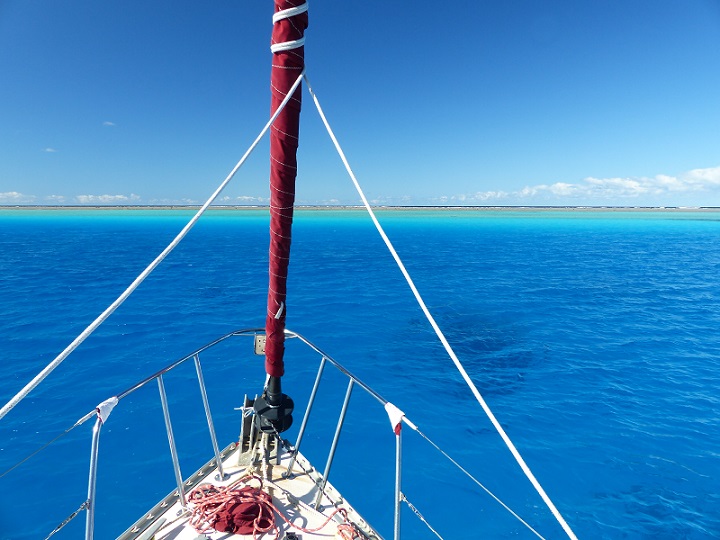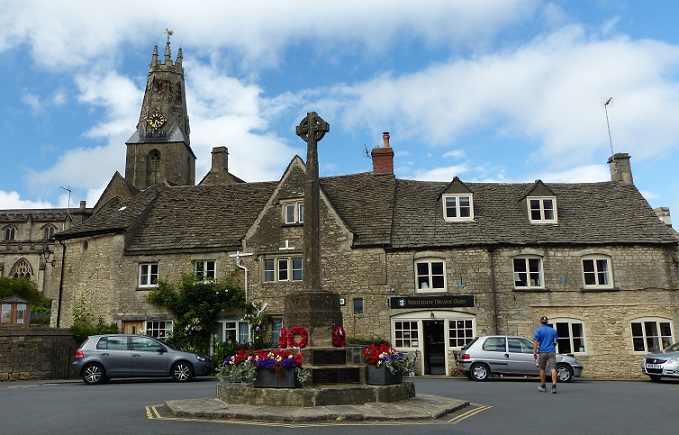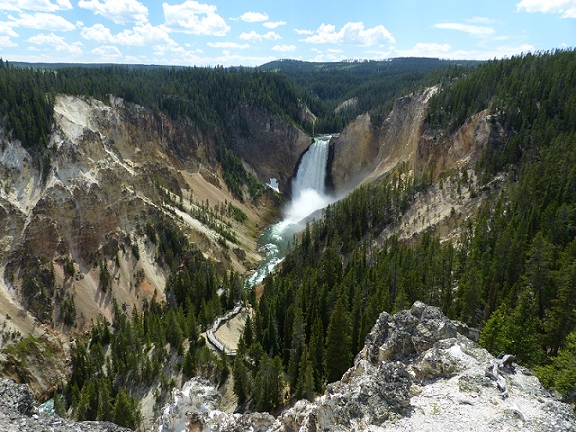
Tregoning
12 April 2024 | We are back aboard Tregoning in Mersin Marina, Mersin, Türkiye
02 April 2024 | We are in Toronto Airport, Canada: Tregoning is in Mersin Marina, Mersin, Türkiye
25 February 2024 | We are back in Gainesville, FL: Tregoning is in Mersin Marina, Mersin, Türkiye
18 February 2024 | We are in Glenwood, New Mexico: Tregoning is in Mersin Marina, Mersin, Türkiye
12 February 2024 | We are in Morro Bay, California: Tregoning is in Mersin Marina, Mersin, Türkiye
19 January 2024 | We are in Vancouver, BC Canada: Tregoning is in Mersin Marina, Mersin, Türkiye
01 January 2024 | We are in Washington State: Tregoning is in Mersin Marina, Mersin, Türkiye
15 December 2023 | We are in Minnesota: Tregoning is in Mersin Marina, Mersin, Türkiye
18 November 2023 | We are in Florida: Tregoning is in Mersin Marina, Mersin, Türkiye
29 October 2023 | We're in Florida - Tregoning is at B-dock, Mersin Marina, Mersin, Türkiye
21 October 2023 | 7 Oda Kapadokya Cave Hotel, Ürgüp, Türkiye
14 October 2023 | Hotel Aşikoğlu, Boğazkale, Türkiye
07 October 2023 | B-dock, Mersin Marina, Mersin, Türkiye
19 September 2023 | “Chez Jon & Angela”, Near Otterton, Devon, UK
14 September 2023 | Airbnb in Fortuneswell on the Isle of Portland, Dorset, UK
11 September 2023 | With Mike, Grange-over-Sands, Cumbria, UK
03 September 2023 | Ardington House, Ardington, Oxfordshire, UK
24 August 2023 | Near "Chez Joan and Peter", College of Roseisle, Moray, Scotland
11 August 2023 | Andrew's house (not exactly), Lichfield, UK
22 July 2023 | Chez Gail, near the New York Café, Budapest, Hungary
Fa’a Samoa – Island Culture
10 October 2017 | Apia Marina, `Upolu Island, Samoa
Photo: Three fire-dancers at the Siva Afi fiafia show across the street from the marina
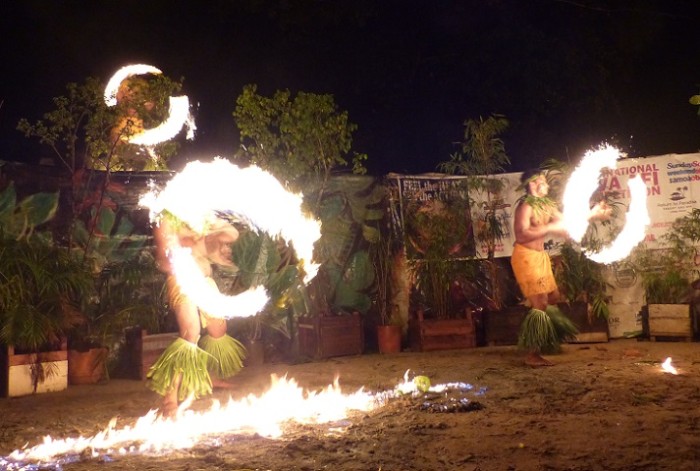
Visitors to Samoa quickly learn that the people are very friendly and relaxed. Outside the busiest areas, cheery greetings and a smile are almost always forthcoming from people as they pass. But behind this casual appearance, the fa'a Samoa or Samoan Way is rigorously upheld, especially in the many villages outside Apia.
This lifestyle is based on ´aiga, extended family groups, to which the individual is subordinate. The emphasis in Samoan life is about serving and improving the status of your ´aiga rather than personal advancement. The aged and disabled are looked after by families not the taxpayer, and with additional, significant village and church obligations, there are few opportunities for accumulating individual wealth, especially as most land is communally owned.
Each ´aiga elects a head or matai who represents the family on the village council or fono, which is led by the high chief of the village or ali´i. Each village also has a person who liaises between the village and the national government and this combination of mayor and police-chief is called the pulenu'u. To coordinate between the ali´i and other outside entities and to lead ceremonial duties, the village will also have one or more orators or talufale. Other members of the village are: men responsible for fishing or growing food; married women, who serve their husbands and his family; widowed or single women who provide hospitality and various gift items (decorated bark cloth or finely woven mats); and children. Respect for elders is a critical component of fa'a Samoa and children are expected to obey older siblings and all adults in the village.
As in Tonga, men who see themselves as female and so dress and act like women, are accepted as a third gender called fa´afafine (meaning to be a woman). Most fa´afafine immerse themselves in Samoan culture because while fa´a Samoa includes a respect fa´afafine, the Western religious influences have been less tolerant. Many fa´afafine work in the hotel and tourism industries thanks to their flair for performance and social interactions.
Also similar to Tonga, many Samoan family members move to New Zealand, Australia, or the US but their commitment to their ´aiga is often continued by regularly wiring money back to Samoa. These overseas Samoans include a disproportionate number of professional athletes because the playing of sports, such as rugby, volleyball, basketball, netball, and a local version of cricket, are considered important community activities. Members of the national rugby teams, Manu Samoa for rugby union and Toa Samoa for rugby league (do not ask me what the differences are), are considered local heroes, especially with the rugby league World Cup in Japan just a few weeks away.
While it is one thing to read about these aspects of fa´a Samoa, what does the typical visitor actually get to see? I will address more of visible components of contemporary village life in the following two posts but here I will focus on the aspects of traditional Samoan life that are deliberately put on display for tourists.
The first of these that we attended was the Cultural Show at the Visitor Information Center. Run at 10:30 am on Tuesdays, Wednesdays, and Thursday, these shows are an absolute "must do" event in Apia. Having seen the large audience on a Tuesday, with Patty and Steve (SV Armagh) and Pam and Eric (SV Pier-a-Mer III), we hastened to the Center early on Thursday to get front-row seats. In the end, only about 20 people showed-up but while we waited we listened to Samoan music and were taught how to weave pieces of coconut-palm fronds into biodegradable plates and were presented with braided palm head-bands.
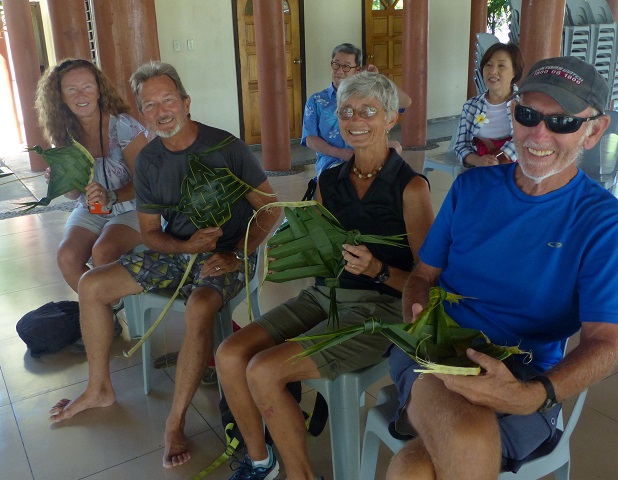
L to R: Patty, Steve, Pam, and Eric with their woven palm-frond plates
The show was led by Chris in a striking traditional appearance of a short, red lava-lava (wrap-around sarong), heavy body tattooing (traditionally concentrated between the navel and knees), a red pandanus-seed necklace, a boar's-tusk choker, face-paint, and assorted palm bands. Chris talked a little about Samoan history and then explained the various activities that we would see demonstrated.
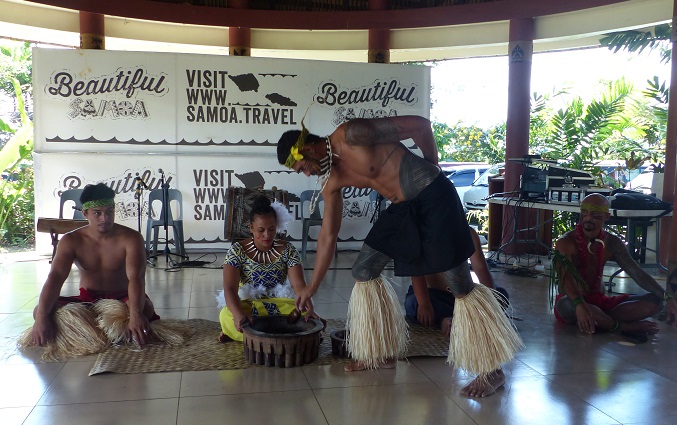
Part of the ´ava ceremony at the Samoan Cultural Show
This started with an ´ava ceremony (a.k.a. kava) which is typically used to start all government and matai meetings as well as all ceremonial events. Derived from the woody roots of the kava (pepper) plant, the drink used to be made by men chewing the root into small pieces that were then soaked in water before straining. These days, ground kava root is used and members of the audience were given small amounts of the muddy drink from a communal (but rinsed) coconut cup. Before drinking, we were invited to express some positive sentiment and then say the appropriate toast, to which an answer was given. Large amounts of kava and/or its frequent use can have a narcotic effect but in inexperienced drinkers this is more typically manifest in a tingling of the lips or tongue. Our doses were too small to be at all effective.
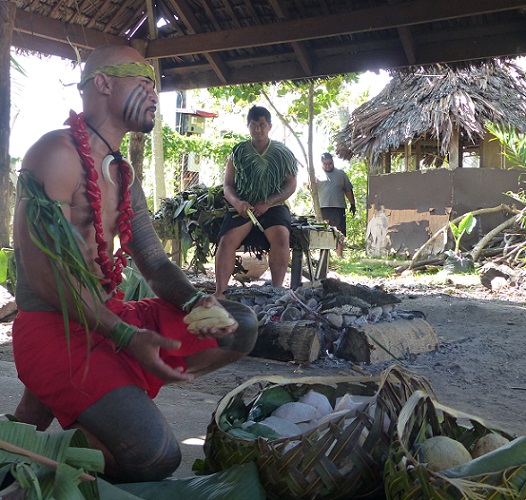
Chris shows us how plantains, taro, and breadfruit will be baked in the pile of hot stones beyond him
Next we moved to a cooking fale where Chris showed us how the traditional staple foods of taro, breadfruit, and plantain were baked in a pile of hot stones. Fales are open-sided buildings of various sizes that traditionally had domed thatch-roofs. Chris also showed us how tender young taro leaves could be baked with coconut cream within a watertight container of banana leaves to produce a dish called palusami that is similar to creamed spinach. Finally, he demonstrated de-husking a coconut using a sharp stick protruding from the ground (the trick it start at the stem end). He then neatly cracked the coconut in half with a strategic tap of a rock (I forget the exact trick here).
Using a stool that has a rounded metal grater at the end, he then grated the white meat of the coconut onto banana leaves. Picking the gratings up in a fibrous material, he then squeezed a thick slurry of sweet white coconut cream back into the scraped coconut halves. Traditionally, the men undertook the cooking because of the strenuous tasks involved in preparing the stone oven, chopping and peeling the taro and breadfruit, and in obtaining the coconut milk. With modern cooking appliances and kitchenware, now women do most daily food preparation.

Chris and assistant show us a stool with a coconut grater
Next, we walked to a fale where wood-carvers were busy making an assortment of traditional objects (e.g., kava bowls), decorative items, and small tourist gifts. Various tools (traditional and modern) and techniques (including shell inlays) were demonstrated and we were invited to buy any of the items on display. These carvers were invited from a village for a week or so, both as demonstrators of their skills but also to try to sell items or to prepare them for the market.
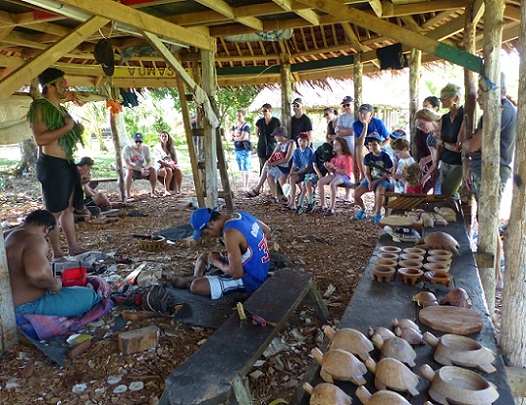
The wood-carving demonstration with small items for sale to tourists (the chain-saw is just out of view)
From there we entered a fale with women preparing various fabrics. Some were purchased cotton on which traditional patterns were being stenciled but the most fascinating was a full demonstration of the preparation of siapo (the Samoan name for tapa or bark cloth). This included: stripping the inner bark off a paper mulberry stem; scraping it with sharp shells to remove tough fibers and starting to enlarge its area; flattening and expanding the bark cloth with blows from a wooden mallet over a wooden anvil (the tapping noise so characteristic in Tongan villages); stretching and drying the bark cloth; adhering two layers to fill in any holes; and applying designs with orange and black stains. Of course, we were invited to buy some of the complete items, so now I will have to get a frame to hang the piece of turtle and dolphin artwork that I bought.
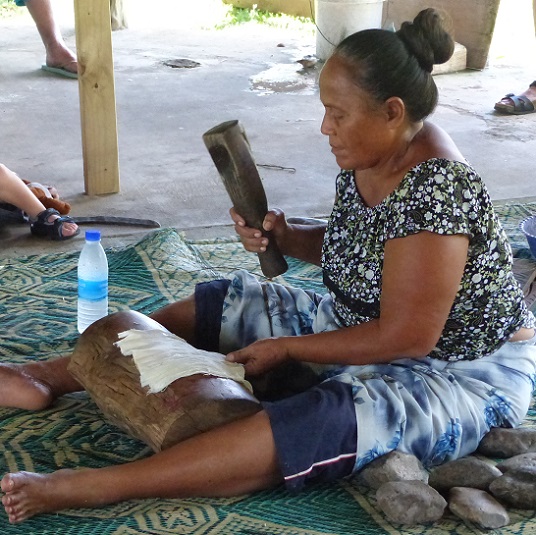
Hammering siapo
I was not sorry that there was no demonstration of art of traditional tatau or tattooing that day. It only occurs if someone local wants such a tattoo and is willing to have an inquisitive audience. I assume that this demonstration would be with traditional tools (sharks' teeth, boar's tusks, and sharpened wooden implements) rather than modern ink-guns but neither particularly appealed to me. Legend suggests that two girls from Fiji introduced the art of tatau to Samoa.
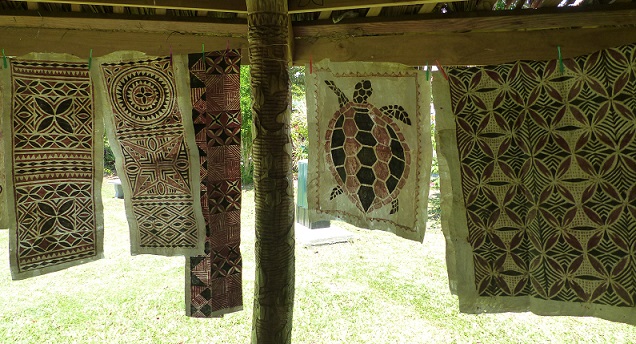
Samples of siapo for sale
Instead, after the extended siapo demonstration, the food had been cooked and we were given palm-frond plates of the baked vegetables and palusami that we had watched being prepared earlier. While we ate, we were entertained with music, singing, and traditional dances. These included gentle hula-style, story-telling dances by the women, and various athletic performances by the men. Two of the most memorable of these involved one dance with wooden paddles and another with fast and rigorous body-slapping. A joyous tradition of the dancing was that even during the most aggressive of the men's pieces, the dancers laughed and smiled. By the end of their energetic performance, most of the enthusiastic and well-fed audience was happy to make a donation to the entertainers.
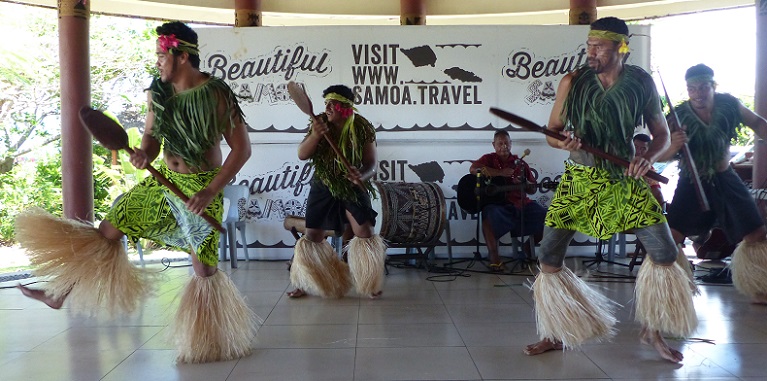
Men performing the paddle-dance
We ate more of the traditional Samoan food and saw more dancing one Tuesday evening when we attended a fiafia show at Siva Afi, a small restaurant across the street from the marina. The food was excellent and included oka (raw tuna in coconut cream) and roast pig (Randall had mine). Many of the men's and women's dances were versions of the hula-, slap-, and paddle-dancing, that we had seen before. They also provided demonstrations of coconut-cream and ´ava preparation, and weaving a basket from coconut-palm fronds. Although the background music was prerecorded, the often rapid beat was maintained using traditional drums that were carved from a hollowed-out log.
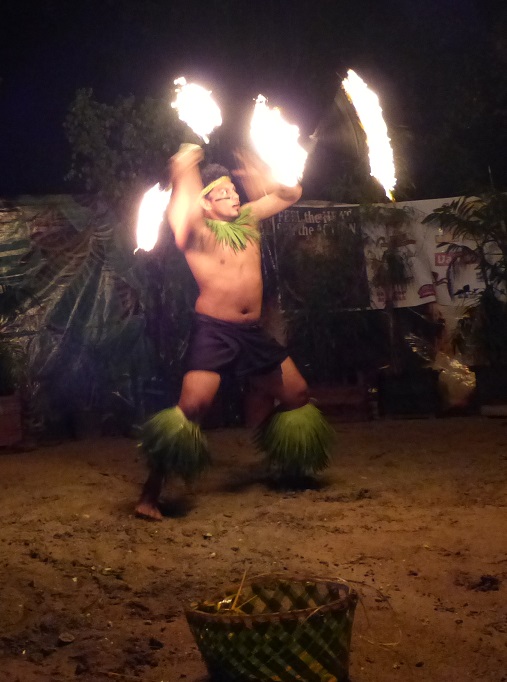
Twirling a pair of fire-batons with a basket made from a coconut-palm frond in the foreground
The highlight of the show, however, was the fire-dancing. Performed by boys and young men, this involves the fast and furious twirling of one or two batons that are flaming at both ends. What made this particular show most impressive was that some of the boys performing were street children who refused, or were unable, to go to school. The manager had persuaded them to learn a traditional skill and was training them to become professional performers. Needless to say, this story helped to elicit more generous donations during the final, slow and sinuous siva dance that is traditionally undertaken by the village taupou (usually the daughter of a high chief) wearing a tall and elaborate headdress. The taupou also usually presides over village ´ava ceremonies.

Fiafia performers (and a few guests) with the taupou in her tall headdress in the center
While these cultural shows with their elaborate traditional garb were very much focused at visitors to Samoa, a good proportion of these practices are still included in the modern nation. Lava-lavas are commonly worn (usually over shorts) by men and women at all times and places. Fiafias are performed at weddings, birthdays, and opening ceremonies. Traditional styles of tattoo on men are popular. Siapo and le Toga (finely woven pandanus mats) are "the gifts of the women" that must be exchanged at formal ceremonies, while "the gifts of the men" are agricultural products.
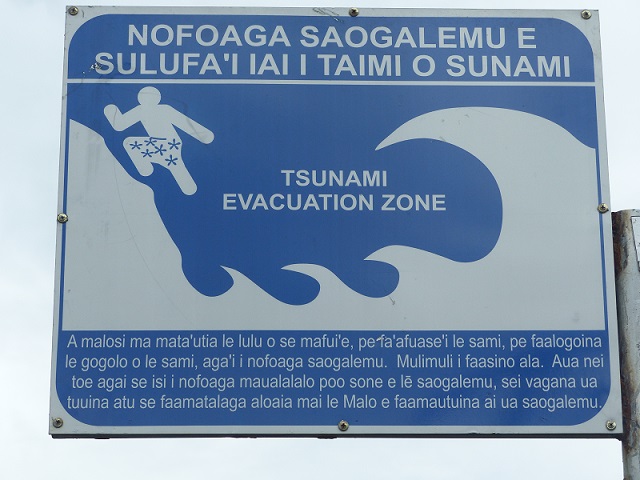
Even the stick figure on the tsunami evacuation zone sign is wearing a decorated lava-lava
The other highly influential aspect of modern Samoan culture is Christianity. In his summary of Samoan history, Chris suggested that Samoan society was particularly open to Christianity because they already believed in spiritual deities rather than worshiping gods of physical objects (sky, sea, forests, etc.)
Samoa has been inhabited for 3,000 years, since the arrival of the ocean-crossing Lapita people from the Solomon Islands and Vanuatu. Whalers, pirates, and escaped convicts may have reached Samoa before 1722, but that is when the first recorded contact of a Dutch explorer, Jacob Roggeveen, occurred in what is now American Samoa. Numerous Europeans brought technological skills and diseases to the Samoan Islands during the following century. The arrival of members of the London Missionary Society in 1830, was closely followed by Methodist and Catholic missionaries, and then by Mormons in 1888. Similarities in Samoan legend with Christian creation beliefs and the prophecy by war goddess Nafanua that a new religion would arrive in the islands, undoubtedly helped with the conversion of souls, along with an enthusiasm for schools and education.
As a result, each village has several churches that represent the various Christian denominations. Some are relatively simple buildings while others are large, ornate structures that are intended to be better than in the neighboring villages (see pictures of the Catholic cathedral in Apia from the 2nd October post). As in Tonga, family donations to the churches are often sizable and competitive.
Services are held in the churches most days and almost everyone attends in their best clothes on Sunday morning, before the families gather for the feast of to´ona´i or Sunday lunch. In many villages, evening prayers called sa (meaning sacred) are a period of inactivity or curfew for about 10 to 15 minutes. A gong is sounded between 6pm and 7pm in preparation for sa, which starts with the second gong and concludes at the third gong. Even visitors are expected to stop and sit quietly.

An example of an elaborate tomb in someone's front yard
Another tradition that we had first observed in American Samoa, is the burying of family members in the front yard. Sometimes these are simple vaults that are also used as flat surfaces for domestic activities such as drying clothes. Often there are elaborate headstones and sometimes quite substantial structures have been built around the vaults. There are a few cemeteries as well but these are much less obvious and colorful than they are in Tonga. Randall reminded me that he does not want to be interred in the middle of the garden or by the car-port.
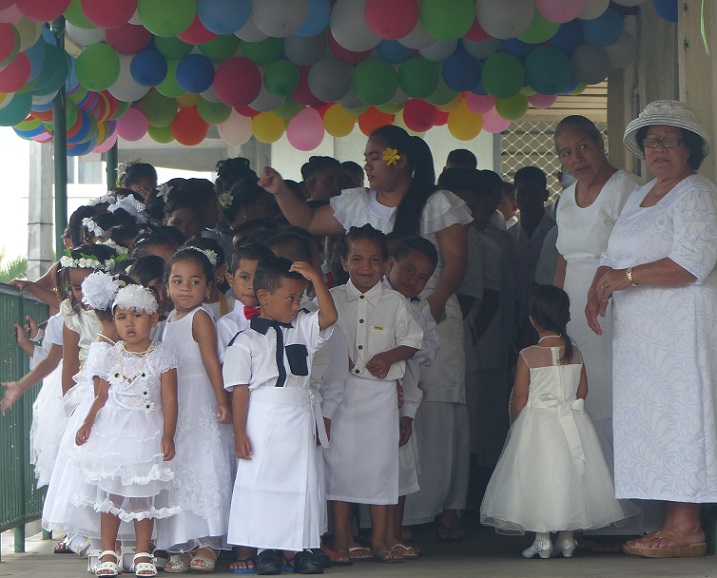
Organized by height, children at this church wait patiently under a cloud of balloons for their processional entrance
Beautiful harmonious singing in church is undoubtedly as important in Samoa as elsewhere in Polynesia. After attending the long service in Tongan on Niuatoputapu, Randall and I could not quite bring ourselves to attend a church service in Apia but our stay there did coincide with White Sunday. This is an annual children's day when children (and any adults who so choose) dress in white and attend a special service in which they are the star attraction. The festivities continue when children are allowed to eat first and they receive new clothes and toys. The significance of White Sunday is indicated by the fact that the following day is a national holiday. We walked around several churches near the marina on White Sunday and it was a joy to see so many children spotlessly dressed and excited about their special day. What a privilege it was to witness this beautiful Samoan tradition!
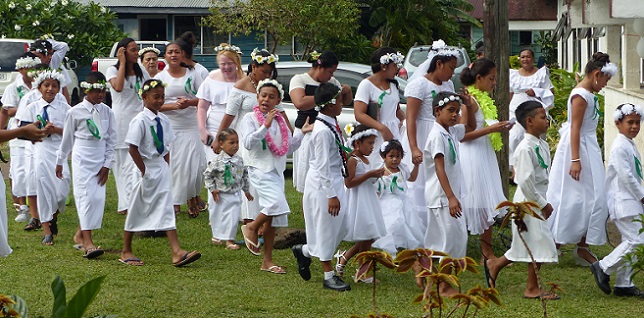
A slightly more casual approach to the White Sunday procession at this church
This lifestyle is based on ´aiga, extended family groups, to which the individual is subordinate. The emphasis in Samoan life is about serving and improving the status of your ´aiga rather than personal advancement. The aged and disabled are looked after by families not the taxpayer, and with additional, significant village and church obligations, there are few opportunities for accumulating individual wealth, especially as most land is communally owned.
Each ´aiga elects a head or matai who represents the family on the village council or fono, which is led by the high chief of the village or ali´i. Each village also has a person who liaises between the village and the national government and this combination of mayor and police-chief is called the pulenu'u. To coordinate between the ali´i and other outside entities and to lead ceremonial duties, the village will also have one or more orators or talufale. Other members of the village are: men responsible for fishing or growing food; married women, who serve their husbands and his family; widowed or single women who provide hospitality and various gift items (decorated bark cloth or finely woven mats); and children. Respect for elders is a critical component of fa'a Samoa and children are expected to obey older siblings and all adults in the village.
As in Tonga, men who see themselves as female and so dress and act like women, are accepted as a third gender called fa´afafine (meaning to be a woman). Most fa´afafine immerse themselves in Samoan culture because while fa´a Samoa includes a respect fa´afafine, the Western religious influences have been less tolerant. Many fa´afafine work in the hotel and tourism industries thanks to their flair for performance and social interactions.
Also similar to Tonga, many Samoan family members move to New Zealand, Australia, or the US but their commitment to their ´aiga is often continued by regularly wiring money back to Samoa. These overseas Samoans include a disproportionate number of professional athletes because the playing of sports, such as rugby, volleyball, basketball, netball, and a local version of cricket, are considered important community activities. Members of the national rugby teams, Manu Samoa for rugby union and Toa Samoa for rugby league (do not ask me what the differences are), are considered local heroes, especially with the rugby league World Cup in Japan just a few weeks away.
While it is one thing to read about these aspects of fa´a Samoa, what does the typical visitor actually get to see? I will address more of visible components of contemporary village life in the following two posts but here I will focus on the aspects of traditional Samoan life that are deliberately put on display for tourists.
The first of these that we attended was the Cultural Show at the Visitor Information Center. Run at 10:30 am on Tuesdays, Wednesdays, and Thursday, these shows are an absolute "must do" event in Apia. Having seen the large audience on a Tuesday, with Patty and Steve (SV Armagh) and Pam and Eric (SV Pier-a-Mer III), we hastened to the Center early on Thursday to get front-row seats. In the end, only about 20 people showed-up but while we waited we listened to Samoan music and were taught how to weave pieces of coconut-palm fronds into biodegradable plates and were presented with braided palm head-bands.

L to R: Patty, Steve, Pam, and Eric with their woven palm-frond plates
The show was led by Chris in a striking traditional appearance of a short, red lava-lava (wrap-around sarong), heavy body tattooing (traditionally concentrated between the navel and knees), a red pandanus-seed necklace, a boar's-tusk choker, face-paint, and assorted palm bands. Chris talked a little about Samoan history and then explained the various activities that we would see demonstrated.

Part of the ´ava ceremony at the Samoan Cultural Show
This started with an ´ava ceremony (a.k.a. kava) which is typically used to start all government and matai meetings as well as all ceremonial events. Derived from the woody roots of the kava (pepper) plant, the drink used to be made by men chewing the root into small pieces that were then soaked in water before straining. These days, ground kava root is used and members of the audience were given small amounts of the muddy drink from a communal (but rinsed) coconut cup. Before drinking, we were invited to express some positive sentiment and then say the appropriate toast, to which an answer was given. Large amounts of kava and/or its frequent use can have a narcotic effect but in inexperienced drinkers this is more typically manifest in a tingling of the lips or tongue. Our doses were too small to be at all effective.

Chris shows us how plantains, taro, and breadfruit will be baked in the pile of hot stones beyond him
Next we moved to a cooking fale where Chris showed us how the traditional staple foods of taro, breadfruit, and plantain were baked in a pile of hot stones. Fales are open-sided buildings of various sizes that traditionally had domed thatch-roofs. Chris also showed us how tender young taro leaves could be baked with coconut cream within a watertight container of banana leaves to produce a dish called palusami that is similar to creamed spinach. Finally, he demonstrated de-husking a coconut using a sharp stick protruding from the ground (the trick it start at the stem end). He then neatly cracked the coconut in half with a strategic tap of a rock (I forget the exact trick here).
Using a stool that has a rounded metal grater at the end, he then grated the white meat of the coconut onto banana leaves. Picking the gratings up in a fibrous material, he then squeezed a thick slurry of sweet white coconut cream back into the scraped coconut halves. Traditionally, the men undertook the cooking because of the strenuous tasks involved in preparing the stone oven, chopping and peeling the taro and breadfruit, and in obtaining the coconut milk. With modern cooking appliances and kitchenware, now women do most daily food preparation.

Chris and assistant show us a stool with a coconut grater
Next, we walked to a fale where wood-carvers were busy making an assortment of traditional objects (e.g., kava bowls), decorative items, and small tourist gifts. Various tools (traditional and modern) and techniques (including shell inlays) were demonstrated and we were invited to buy any of the items on display. These carvers were invited from a village for a week or so, both as demonstrators of their skills but also to try to sell items or to prepare them for the market.

The wood-carving demonstration with small items for sale to tourists (the chain-saw is just out of view)
From there we entered a fale with women preparing various fabrics. Some were purchased cotton on which traditional patterns were being stenciled but the most fascinating was a full demonstration of the preparation of siapo (the Samoan name for tapa or bark cloth). This included: stripping the inner bark off a paper mulberry stem; scraping it with sharp shells to remove tough fibers and starting to enlarge its area; flattening and expanding the bark cloth with blows from a wooden mallet over a wooden anvil (the tapping noise so characteristic in Tongan villages); stretching and drying the bark cloth; adhering two layers to fill in any holes; and applying designs with orange and black stains. Of course, we were invited to buy some of the complete items, so now I will have to get a frame to hang the piece of turtle and dolphin artwork that I bought.

Hammering siapo
I was not sorry that there was no demonstration of art of traditional tatau or tattooing that day. It only occurs if someone local wants such a tattoo and is willing to have an inquisitive audience. I assume that this demonstration would be with traditional tools (sharks' teeth, boar's tusks, and sharpened wooden implements) rather than modern ink-guns but neither particularly appealed to me. Legend suggests that two girls from Fiji introduced the art of tatau to Samoa.

Samples of siapo for sale
Instead, after the extended siapo demonstration, the food had been cooked and we were given palm-frond plates of the baked vegetables and palusami that we had watched being prepared earlier. While we ate, we were entertained with music, singing, and traditional dances. These included gentle hula-style, story-telling dances by the women, and various athletic performances by the men. Two of the most memorable of these involved one dance with wooden paddles and another with fast and rigorous body-slapping. A joyous tradition of the dancing was that even during the most aggressive of the men's pieces, the dancers laughed and smiled. By the end of their energetic performance, most of the enthusiastic and well-fed audience was happy to make a donation to the entertainers.

Men performing the paddle-dance
We ate more of the traditional Samoan food and saw more dancing one Tuesday evening when we attended a fiafia show at Siva Afi, a small restaurant across the street from the marina. The food was excellent and included oka (raw tuna in coconut cream) and roast pig (Randall had mine). Many of the men's and women's dances were versions of the hula-, slap-, and paddle-dancing, that we had seen before. They also provided demonstrations of coconut-cream and ´ava preparation, and weaving a basket from coconut-palm fronds. Although the background music was prerecorded, the often rapid beat was maintained using traditional drums that were carved from a hollowed-out log.

Twirling a pair of fire-batons with a basket made from a coconut-palm frond in the foreground
The highlight of the show, however, was the fire-dancing. Performed by boys and young men, this involves the fast and furious twirling of one or two batons that are flaming at both ends. What made this particular show most impressive was that some of the boys performing were street children who refused, or were unable, to go to school. The manager had persuaded them to learn a traditional skill and was training them to become professional performers. Needless to say, this story helped to elicit more generous donations during the final, slow and sinuous siva dance that is traditionally undertaken by the village taupou (usually the daughter of a high chief) wearing a tall and elaborate headdress. The taupou also usually presides over village ´ava ceremonies.

Fiafia performers (and a few guests) with the taupou in her tall headdress in the center
While these cultural shows with their elaborate traditional garb were very much focused at visitors to Samoa, a good proportion of these practices are still included in the modern nation. Lava-lavas are commonly worn (usually over shorts) by men and women at all times and places. Fiafias are performed at weddings, birthdays, and opening ceremonies. Traditional styles of tattoo on men are popular. Siapo and le Toga (finely woven pandanus mats) are "the gifts of the women" that must be exchanged at formal ceremonies, while "the gifts of the men" are agricultural products.

Even the stick figure on the tsunami evacuation zone sign is wearing a decorated lava-lava
The other highly influential aspect of modern Samoan culture is Christianity. In his summary of Samoan history, Chris suggested that Samoan society was particularly open to Christianity because they already believed in spiritual deities rather than worshiping gods of physical objects (sky, sea, forests, etc.)
Samoa has been inhabited for 3,000 years, since the arrival of the ocean-crossing Lapita people from the Solomon Islands and Vanuatu. Whalers, pirates, and escaped convicts may have reached Samoa before 1722, but that is when the first recorded contact of a Dutch explorer, Jacob Roggeveen, occurred in what is now American Samoa. Numerous Europeans brought technological skills and diseases to the Samoan Islands during the following century. The arrival of members of the London Missionary Society in 1830, was closely followed by Methodist and Catholic missionaries, and then by Mormons in 1888. Similarities in Samoan legend with Christian creation beliefs and the prophecy by war goddess Nafanua that a new religion would arrive in the islands, undoubtedly helped with the conversion of souls, along with an enthusiasm for schools and education.
As a result, each village has several churches that represent the various Christian denominations. Some are relatively simple buildings while others are large, ornate structures that are intended to be better than in the neighboring villages (see pictures of the Catholic cathedral in Apia from the 2nd October post). As in Tonga, family donations to the churches are often sizable and competitive.
Services are held in the churches most days and almost everyone attends in their best clothes on Sunday morning, before the families gather for the feast of to´ona´i or Sunday lunch. In many villages, evening prayers called sa (meaning sacred) are a period of inactivity or curfew for about 10 to 15 minutes. A gong is sounded between 6pm and 7pm in preparation for sa, which starts with the second gong and concludes at the third gong. Even visitors are expected to stop and sit quietly.

An example of an elaborate tomb in someone's front yard
Another tradition that we had first observed in American Samoa, is the burying of family members in the front yard. Sometimes these are simple vaults that are also used as flat surfaces for domestic activities such as drying clothes. Often there are elaborate headstones and sometimes quite substantial structures have been built around the vaults. There are a few cemeteries as well but these are much less obvious and colorful than they are in Tonga. Randall reminded me that he does not want to be interred in the middle of the garden or by the car-port.

Organized by height, children at this church wait patiently under a cloud of balloons for their processional entrance
Beautiful harmonious singing in church is undoubtedly as important in Samoa as elsewhere in Polynesia. After attending the long service in Tongan on Niuatoputapu, Randall and I could not quite bring ourselves to attend a church service in Apia but our stay there did coincide with White Sunday. This is an annual children's day when children (and any adults who so choose) dress in white and attend a special service in which they are the star attraction. The festivities continue when children are allowed to eat first and they receive new clothes and toys. The significance of White Sunday is indicated by the fact that the following day is a national holiday. We walked around several churches near the marina on White Sunday and it was a joy to see so many children spotlessly dressed and excited about their special day. What a privilege it was to witness this beautiful Samoan tradition!

A slightly more casual approach to the White Sunday procession at this church
Comments
| Vessel Name: | Tregoning |
| Vessel Make/Model: | Morgan Classic 41 |
| Hailing Port: | Gainesville, FL |
| Crew: | Alison and Randall |
| About: | We cast-off from Fernandina Beach in north Florida on 1st June 2008 and we have been cruising on Tregoning ever since. Before buying Tregoning, both of us had been sailing on smaller boats for many years and had worked around boats and water throughout our careers. |
| Extra: | “Tregoning” (rhymes with “belonging”) and is a Cornish word (meaning “homestead of Cohnan” or “farm by the ash trees”) and was Alison's mother’s middle name. Cornwall is in southwest England and is where Alison grew-up. |
Tregoning's Photos - Main
 |
Extra photographs from our three-week campervan tour of the South Island from November 15th to December 5th 2015
217 Photos
Created 4 January 2016
|
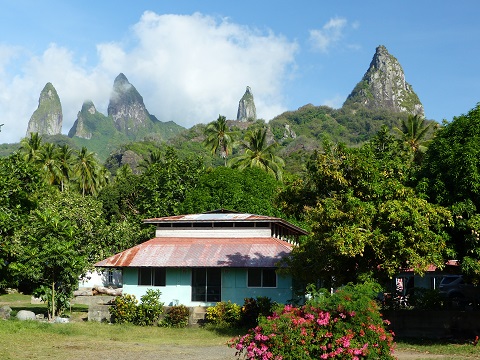 |
Random pictures from our month spent on the islands of Hiva Oa, Tahuata, Ua Pou, and Nuku Hiva
45 Photos
Created 18 July 2015
|
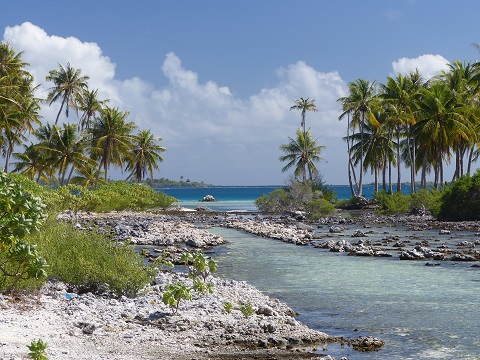 |
Random pictures from our month spent in 4 Tuamotu Atolls; Ahe, Fakarava, Tahanea, and Toau
32 Photos
Created 1 July 2015
|
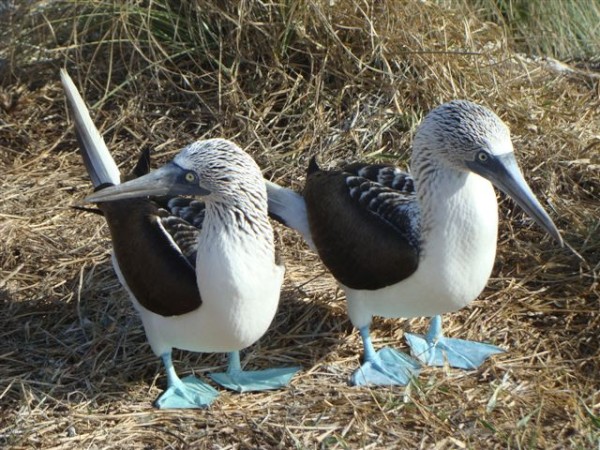 |
Some of the birds, fish, reptiles, and mammals (and others) that we have seen in Mexico
74 Photos
Created 5 May 2014
|
Tregoning

Who: Alison and Randall
Port: Gainesville, FL
